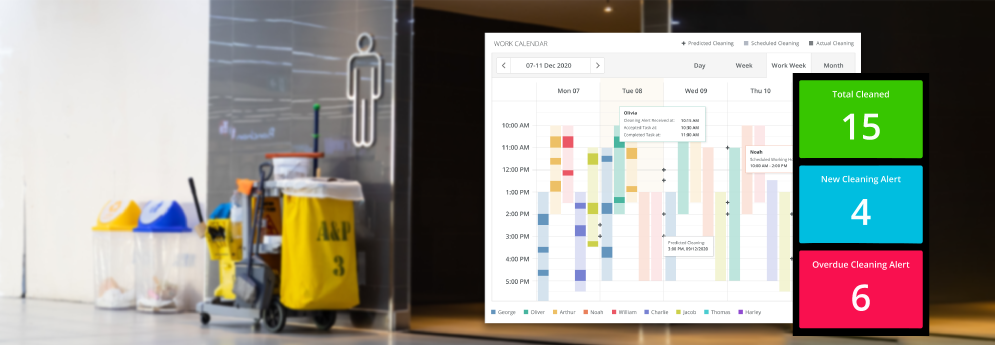Explore how implementing people counting sensors in washrooms aids in efficient resource allocation while ensuring cleanliness and enhancing user experiences.

Implementing a people counting system for scheduling cleaners for washrooms can be an effective way to optimise cleaning routines and ensure washrooms are well-maintained. Here’s a suggested approach:
Install People Counting Sensors: Install people counting sensors or devices in the washrooms to accurately track the number of people entering and exiting the facility. Place the sensors strategically to cover the entry and exit points, ensuring proper installation and calibration for accurate counting.
Define Cleaning Triggers: Establish specific triggers or thresholds based on foot traffic patterns and cleanliness standards to determine when cleaning is required. For example, you may set a trigger such as cleaning after a certain number of people have used the washroom or at specific time intervals.
Collect and Analyse Data: Collect data from the people counting system over a significant period to gather reliable insights. Analyse the data to identify patterns and trends in washroom usage, such as peak hours, busiest days, or periods of high traffic.
Determine Cleaning Frequency: Based on the analysis of the data, determine the appropriate cleaning frequency for different times of the day or days of the week. This information will help you identify the periods when the washrooms require more frequent cleaning.
Schedule Cleaning Resources: Utilise the insights gained from the people counting system to optimise the scheduling of cleaning resources. Allocate the appropriate number of cleaners during peak hours or when foot traffic reaches predetermined thresholds. Ensure sufficient staff coverage to maintain cleanliness standards.
Implement Real-Time Alerts: Set up real-time alerts or notifications triggered by the people counting system when foot traffic exceeds predefined thresholds or when the washroom requires immediate attention. This enables prompt cleaning responses and ensures a timely and proactive approach to maintenance.
Regular Review and Adjustment: Continuously monitor the data and review the effectiveness of the cleaning schedules and resource allocation. Make necessary adjustments to the cleaning routines based on evolving patterns, changes in foot traffic, or feedback from staff or customers.
Communication and Training: Clearly communicate the purpose and benefits of the people counting system to the cleaning staff. Provide training on how to interpret and utilise the data effectively to optimise their cleaning efforts. Encourage open communication channels for feedback and insights from the cleaners regarding the system’s effectiveness.
Evaluate and Improve: Regularly evaluate the impact of the people counting system on the cleanliness and maintenance of the washrooms. Assess customer feedback, staff observations, and the overall cleanliness ratings. Use this feedback to refine the scheduling, cleaning procedures, or adjust the system as needed for continuous improvement.
By implementing a people counting system for scheduling cleaners in washrooms, you can optimise resource allocation, improve cleanliness standards, and ensure a well-maintained environment for your customers and staff. The data-driven approach enables efficient cleaning routines, reduces costs, and enhances overall washroom experiences.











